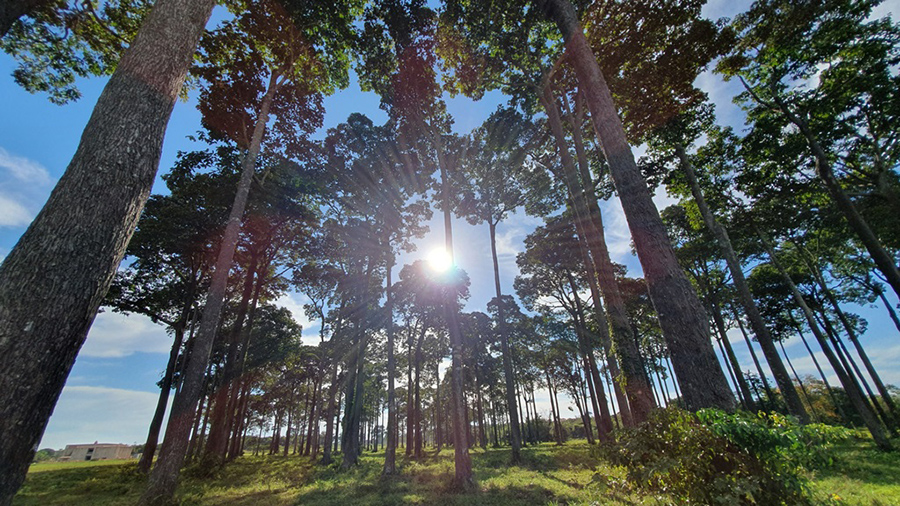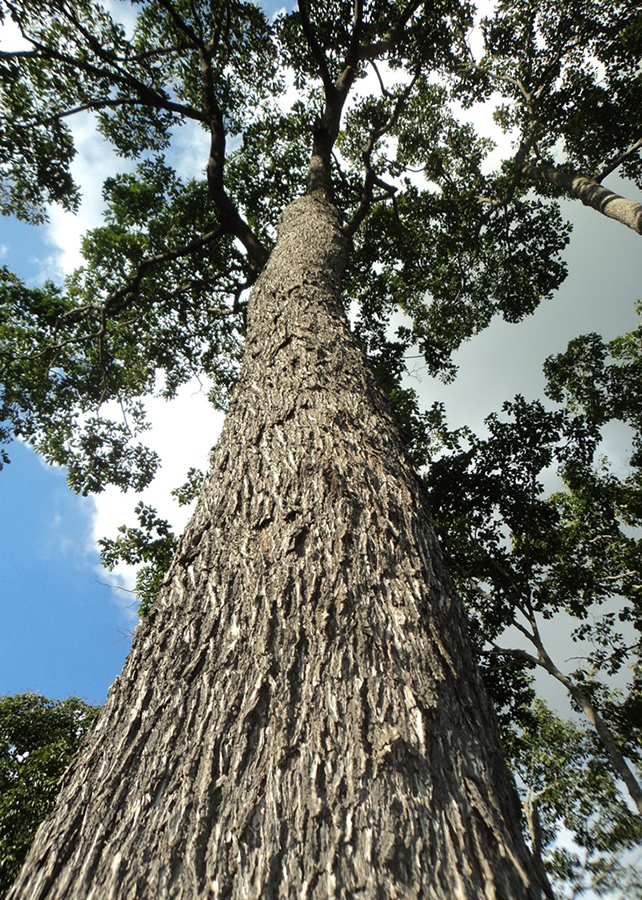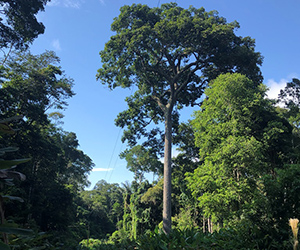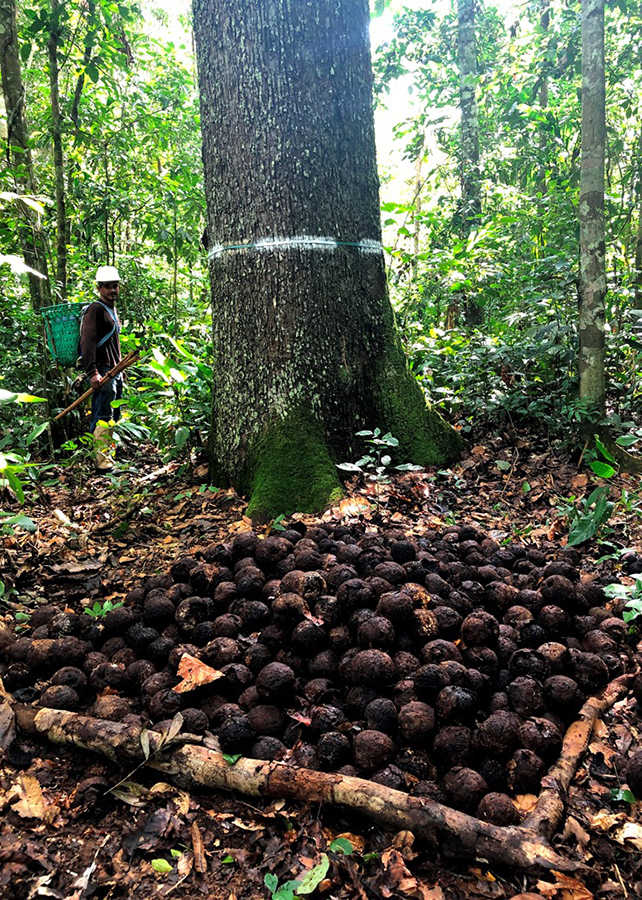It is the first time Brazil nut tree has a reference genome, which is fundamental for research and conservation of the species. New study has already identified genes that determine genetic incompatibility, i.e. which individuals cannot breed with each other. It also identified genes related to selenium metabolism, and others related to resistance to pests and diseases. Each plant genome also identifies each region to which the plant has adapted. This informs conservation strategies based on the evolutionary history of the species and its current and future geographic distribution. The study involved 30 populations spread through the entire Brazilian Amazon region and showed that the genetic diversity of the species changes from one region to another. Scientists from Embrapa and the Federal University of São Carlos (UFSCar) have perfomed the genetic sequencing of the Brazil nut tree (Bertholletia excelsa), an icon of the Amazonian forest not only due to its size and exuberance, but also due to its socioeconomic importance and key role in the conservation of forests. The unprecedented study has already produced important genomic information and one of its biggest contributions will be the acceleration of breeding and genetic improvement of the species. As the tree lives for long, classic breeding would take 50 to 200 years to assess full cycles and select the best plants to obtain desirable traits. This is so because researchers have to study the behavior of different plants in different environments and situations throughout their life cycles to obtain desired responses. However, through genomic sequences and bioinformatics, using gene banks available for other plants, it will be possible to find genes that indicate important traits like drought tolerance, resistance to pathogens or reproductive compatibility, for instance. That is how plants with a better profile are selected quickly, through genetic analysis. Another important factor is that the Brazil nut tree is a species that presents genetic incompatibility, that is, there are individuals in the species that are not able to breed with each other and bear fruit. This makes the identification of incompatible plants fundamental. And the sequencing in question has already contributed to such challenge, as the reference genome for Brazil nut has revealed the presence of genes of reproductive incompatibility, which bring opportunities for the use of genomic tools in the breeding, cultivation and conservation of the species. The recognition of the determinants of genetic compatibility between individuals can facilitate the selection of female individuals to be used in breeding and genetic improvement programs and contribute to increasing productivity in Brazil nut groves. Through the DNA of a Brazil nut seedling, it will be possible to identify the genetic group to which the seedling belongs, which will thus guide the choice of individuals to be used in commercial plantations. “Moreover, other genes of interest can be identified, facilitating the selection of the best plants at the nursery stage and fast forwarding many years of research in the breeding and genetic improvement program, with much safer and faster results,” exemplifies Lúcia Wadt, a researcher from Embrapa Rondônia. Another interesting point is that natural selection as Brazil nut trees adapt to each environment leaves traces in the plant's genome; hence studying such traces is important both for the conservation of the species in the forests and for the selection of trees in breeding programs to boost fruit production. This study is led by Embrapa in partnership with UFSCar, through the project EcogenCast. The work started in 2016 and is in progress. Economic and social importance of the Brazil nut tree The Brazil nut tree is a source of income for over 170,000 people in the Amazon biome In the last five years, it moved an average R$ 116 million annually in Brazil alone. Practically all the Brazil nut production that totalled that sum comes from native forests and, although current figures are not as competitive as many other commodities, its social value and the value for traditional communities are undisputed. Studies that enable the selection of more productive plants that are more adapted to current climate conditions are fundamental for the viability of Brazil nut production and for the conservation of the forests in the Amazon region. In addition to the identification of genes of agronomic interest, the scientists also want to understand the influence of the environment in the structuring of genetic variability in native Brazil nut trees. The findings are expected to inform conservation strategies, based on the evolutionary history of the species, and its current and future geographic distribution. “The study also aims to identify the regions where Brazil nut tree populations can be more vulnerable to climate change and, by extension, reflect the vulnerability of several other species that occur in association with the Brazil nut tree”, adds the UFSCar researcher Karina Martins. Genetic diversity varies by region According to the researchers, an initial analysis performed with 30 populations spread through the whole Brazilian Amazon region showed that native Brazil nut forests present genetic diversity, but with differences between regions. This means that the conservation of the diversity of the species depends on the maintenance of the Brazil nut forests in the different regions where they occur. “A result of this kind of research can be useful for the definition of priority areas for the genetic conservation of the species, as well as recommending key populations for the collection of genetic material to be used in Brazil nut breeding programs”, Wadt comments. Besides such aspects in terms of breeding and conservation, the study will also contribute to shaping the impacts of global climate change on forests, and can help define actions to fight climate change and its impacts, contributing to 13 of the 17 Sustainable Development Goals (SDGs), which are part of the world agenda adopted by United Nations. Genes related to selenium and to resistance to pests In order to inform different projects on the genomics of the species, the reference genome for Brazil nut was assembled through a partnership between Embrapa, UFSCar and the University of Brasilia (UnB), with funding from the São Paulo State Research Support Foundation (Fapesp). The researcher Karina Martins explains that the DNA of a native Brazil nut tree, located in Porto Velho, Rondônia, was sequenced and, with the use of computational tools, it was possible to assemble the species genome almost fully and with high quality. The RNAs obtained from different Brazil nut tree tissues were sequenced and used to identify the genes in the assembled genome and identify their roles. “The public availability of the Brazil nut reference genome will be a fundamental resource to advance knowledge about the species, contributing to the conservation of populations and to breeding and genetic improvement”, the researcher stresses, and adds that they identified a large amount of genes that grant resistance to pests and diseases and genes associated with selenium metabolism. Curiously, when they compared the genomic sequences obtained from Brazil nut trees with genomic databases, they identified a strong association with pathogenic bacteria that attacks sweet corn and other crops and causes Stewart's wilt. The study, which will be published soon, suggests that associations with the bacteria can be beneficial for Brazil nut trees, as not only virulence genes were absent, but also because multiple genes potentially associated with plant growth were identified in the microorganism. Many lines of questioning regarding the conservation, sustainable use and cultivation of the species aimed at the production of Brazil nuts and at tackling climate change can be addressed by these studies. For researcher Lúcia Wadt, the sequenced genome will allow the definition of genetic markers that can be compared with gene databases that already enlist traits like resistance to diseases and tolerance to droughts, for instance. This way, it will be possible to identify marks that shorten the path to the selection of superior plants and thus facilitate the recommendation of genetic material for commercial cropping. Curiously, when they compared the genomic sequences obtained from Brazil nut trees with genomic databases, they identified a strong association with pathogenic bacteria that attacks sweet corn and other crops and causes Stewart's wilt. The study, which will be published soon, suggests that associations with the bacteria can be beneficial for Brazil nut trees, as not only virulence genes were absent, but also because multiple genes potentially associated with plant growth were identified in the microorganism. Many lines of questioning regarding the conservation, sustainable use and cultivation of the species aimed at the production of Brazil nuts and at tackling climate change can be addressed by these studies. For researcher Lúcia Wadt, the sequenced genome will allow the definition of genetic markers that can be compared with gene databases that already enlist traits like resistance to diseases and tolerance to droughts, for instance. This way, it will be possible to identify marks that shorten the path to the selection of superior plants and thus facilitate the recommendation of genetic material for commercial cropping.
-
It is the first time Brazil nut tree has a reference genome, which is fundamental for research and conservation of the species. -
New study has already identified genes that determine genetic incompatibility, i.e. which individuals cannot breed with each other. -
It also identified genes related to selenium metabolism, and others related to resistance to pests and diseases. -
Each plant genome also identifies each region to which the plant has adapted. This informs conservation strategies based on the evolutionary history of the species and its current and future geographic distribution. -
The study involved 30 populations spread through the entire Brazilian Amazon region and showed that the genetic diversity of the species changes from one region to another. |
Scientists from Embrapa and the Federal University of São Carlos (UFSCar) have perfomed the genetic sequencing of the Brazil nut tree (Bertholletia excelsa), an icon of the Amazonian forest not only due to its size and exuberance, but also due to its socioeconomic importance and key role in the conservation of forests. The unprecedented study has already produced important genomic information and one of its biggest contributions will be the acceleration of breeding and genetic improvement of the species.
As the tree lives for long, classic breeding would take 50 to 200 years to assess full cycles and select the best plants to obtain desirable traits. This is so because researchers have to study the behavior of different plants in different environments and situations throughout their life cycles to obtain desired responses.
However, through genomic sequences and bioinformatics, using gene banks available for other plants, it will be possible to find genes that indicate important traits like drought tolerance, resistance to pathogens or reproductive compatibility, for instance. That is how plants with a better profile are selected quickly, through genetic analysis.
Another important factor is that the Brazil nut tree is a species that presents genetic incompatibility, that is, there are individuals in the species that are not able to breed with each other and bear fruit. This makes the identification of incompatible plants fundamental. And the sequencing in question has already contributed to such challenge, as the reference genome for Brazil nut has revealed the presence of genes of reproductive incompatibility, which bring opportunities for the use of genomic tools in the breeding, cultivation and conservation of the species. The recognition of the determinants of genetic compatibility between individuals can facilitate the selection of female individuals to be used in breeding and genetic improvement programs and contribute to increasing productivity in Brazil nut groves.
Through the DNA of a Brazil nut seedling, it will be possible to identify the genetic group to which the seedling belongs, which will thus guide the choice of individuals to be used in commercial plantations.
“Moreover, other genes of interest can be identified, facilitating the selection of the best plants at the nursery stage and fast forwarding many years of research in the breeding and genetic improvement program, with much safer and faster results,” exemplifies Lúcia Wadt, a researcher from Embrapa Rondônia.
Another interesting point is that natural selection as Brazil nut trees adapt to each environment leaves traces in the plant's genome; hence studying such traces is important both for the conservation of the species in the forests and for the selection of trees in breeding programs to boost fruit production. This study is led by Embrapa in partnership with UFSCar, through the project EcogenCast. The work started in 2016 and is in progress.

Economic and social importance of the Brazil nut tree The Brazil nut tree is a source of income for over 170,000 people in the Amazon biome In the last five years, it moved an average R$ 116 million annually in Brazil alone. Practically all the Brazil nut production that totalled that sum comes from native forests and, although current figures are not as competitive as many other commodities, its social value and the value for traditional communities are undisputed. Studies that enable the selection of more productive plants that are more adapted to current climate conditions are fundamental for the viability of Brazil nut production and for the conservation of the forests in the Amazon region. |
In addition to the identification of genes of agronomic interest, the scientists also want to understand the influence of the environment in the structuring of genetic variability in native Brazil nut trees. The findings are expected to inform conservation strategies, based on the evolutionary history of the species, and its current and future geographic distribution. “The study also aims to identify the regions where Brazil nut tree populations can be more vulnerable to climate change and, by extension, reflect the vulnerability of several other species that occur in association with the Brazil nut tree”, adds the UFSCar researcher Karina Martins.

Genetic diversity varies by region
According to the researchers, an initial analysis performed with 30 populations spread through the whole Brazilian Amazon region showed that native Brazil nut forests present genetic diversity, but with differences between regions. This means that the conservation of the diversity of the species depends on the maintenance of the Brazil nut forests in the different regions where they occur. “A result of this kind of research can be useful for the definition of priority areas for the genetic conservation of the species, as well as recommending key populations for the collection of genetic material to be used in Brazil nut breeding programs”, Wadt comments.
Besides such aspects in terms of breeding and conservation, the study will also contribute to shaping the impacts of global climate change on forests, and can help define actions to fight climate change and its impacts, contributing to 13 of the 17 Sustainable Development Goals (SDGs), which are part of the world agenda adopted by United Nations.
 Genes related to selenium and to resistance to pests
Genes related to selenium and to resistance to pests
In order to inform different projects on the genomics of the species, the reference genome for Brazil nut was assembled through a partnership between Embrapa, UFSCar and the University of Brasilia (UnB), with funding from the São Paulo State Research Support Foundation (Fapesp).
The researcher Karina Martins explains that the DNA of a native Brazil nut tree, located in Porto Velho, Rondônia, was sequenced and, with the use of computational tools, it was possible to assemble the species genome almost fully and with high quality. The RNAs obtained from different Brazil nut tree tissues were sequenced and used to identify the genes in the assembled genome and identify their roles. “The public availability of the Brazil nut reference genome will be a fundamental resource to advance knowledge about the species, contributing to the conservation of populations and to breeding and genetic improvement”, the researcher stresses, and adds that they identified a large amount of genes that grant resistance to pests and diseases and genes associated with selenium metabolism.
Curiously, when they compared the genomic sequences obtained from Brazil nut trees with genomic databases, they identified a strong association with pathogenic bacteria that attacks sweet corn and other crops and causes Stewart's wilt. The study, which will be published soon, suggests that associations with the bacteria can be beneficial for Brazil nut trees, as not only virulence genes were absent, but also because multiple genes potentially associated with plant growth were identified in the microorganism.
Many lines of questioning regarding the conservation, sustainable use and cultivation of the species aimed at the production of Brazil nuts and at tackling climate change can be addressed by these studies. For researcher Lúcia Wadt, the sequenced genome will allow the definition of genetic markers that can be compared with gene databases that already enlist traits like resistance to diseases and tolerance to droughts, for instance. This way, it will be possible to identify marks that shorten the path to the selection of superior plants and thus facilitate the recommendation of genetic material for commercial cropping.
Curiously, when they compared the genomic sequences obtained from Brazil nut trees with genomic databases, they identified a strong association with pathogenic bacteria that attacks sweet corn and other crops and causes Stewart's wilt. The study, which will be published soon, suggests that associations with the bacteria can be beneficial for Brazil nut trees, as not only virulence genes were absent, but also because multiple genes potentially associated with plant growth were identified in the microorganism.
Many lines of questioning regarding the conservation, sustainable use and cultivation of the species aimed at the production of Brazil nuts and at tackling climate change can be addressed by these studies. For researcher Lúcia Wadt, the sequenced genome will allow the definition of genetic markers that can be compared with gene databases that already enlist traits like resistance to diseases and tolerance to droughts, for instance. This way, it will be possible to identify marks that shorten the path to the selection of superior plants and thus facilitate the recommendation of genetic material for commercial cropping.

 Genes related to selenium and to resistance to pests
Genes related to selenium and to resistance to pests